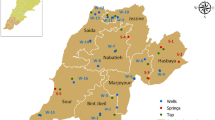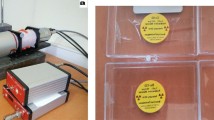Abstract
Drinking water may contain radioactive substances that could present a risk to human health (WHO, Guidelines for drinking-water quality: fourth edition incorporating the first addendum. World Health Organization, Geneva, 2017). Of particular significance for human radiation exposure from drinking water are the naturally occurring radionuclides that originate from the elements of the thorium and uranium decay series, such as 226Ra and 228Ra. These radionuclides can arise in water from natural processes in the ground or human activities involving naturally occurring radioactive materials (WHO, Management of radioactivity in drinking water. World Health Organization, Geneva, 2018). The measurement of radioactivity in drinking water allows the determination of population exposure to radiation by the habitual consumption of water. The aim of this study was to determine gross alpha and gross beta activities, and 226Ra and 228Ra activity concentrations in 28 drinking water samples from the Vojvodina region, in order to check compliance with recent Serbian and European regulations. Gross alpha and beta activity in drinking water samples were determined according to ASTM D7283-06 Standard test method for alpha- and beta-activity in water by liquid scintillation counting (ASTM D7283-06, Standard test method for alpha- and beta- activity in water by liquid scintillation counting. ASTM International West Conshohocken PA, https://www.astm.org, 2006), and measured by PerkinElmer liquid scintillation counter Quantulus 1220. The activity of 226Ra and 228Ra was determined by low-level gamma-spectrometry, and assuming the radioactive equilibrium between 226 and 228Ra and their progenies. For the analyzed radionuclides activity concentration in the water samples dose calculations were carried out. Gross alpha activity for all presented water samples exceeded the recommended guideline activity concentrations of 0.1 Bq L−1 (WHO, Guidelines for drinking-water quality, 2nd edn. World Health Organization, Geneva, 1993). The activity concentrations for 226Ra in 13 of investigated samples are higher than the legally established levels for radionuclide content in drinking water in Serbia and EU (Official Gazette, Rulebook on limits of radionuclides content in drinking water, foodstuffs, feeding stuffs, medicines, general use products, construction materials and other goods that are put on market, 2013; EC, Council Directive 2013/51/EURATOM, 2013). In 16 water samples concentration of 228Ra is higher than recommended. In 20 investigated samples, total dose GD from radionuclides in drinking water is higher than 0.1 mSv year−1 (EC, European Drinking Water Directive 98/83/EC of 3 November 1998 European Commission on the quality of water intended for human consumption. Off J L, 1998). The cancer risk caused by the intake of radium isotopes in drinking water during the lifetime was estimated, and the obtaining results are ranged in the acceptable cancer incidence (WHO, Guidelines for drinking-water quality, 4th edn. World Health Organization, Geneva, 2011; EPA, Cancer risk coefficients for environmental exposures to radionuclides. Environmental Protection Agency, Washington, DC, 1999). The presence of 226Ra and 228Ra are explained on the basis of geological and hydrogeological characteristics of the Vojvodina region.



Similar content being viewed by others
References
Aksin V, Milosavljević S (1982) Geothermal energy: research and application worldwide and in Yugoslavia, with special reference to Vojvodina. JUGOMA, Dubrovnik (in Serbian)
Altkulaca A, Turhanb S, Gumus H (2015) The natural and artificial radionuclides in drinking water samples and consequent population doses. J Radiat Res Appl SC 8:578–582
ASTM D7283-06 (2006) Standard test method for alpha- and beta- activity in water by liquid scintillation counting. ASTM International, West Conshohocken, PA
Čičulić Trifunović M, Rakić M (1977) Explanatory booklet of the Basic geological map 1:100.000 of the SFR Yugoslavia, sheet Novi Sad. Federal Geological Survey Belgrade (in Serbian)
Dalmacija B (2009) Strategy for water supply and water protection in AP Vojvodina. Faculty of Science, Novi Sad, Serbia
Dolinaj D, Ristanović B, Pavić D, Stojanović V, Pašić M (2008) Hydro-geological problems of Vranjaš accumulation (Vojvodina, Serbia). Geogr Pannonica 12(2):69–76
EC (1998) European Drinking Water Directive 98/83/EC of 3 November 1998 European Commission on the quality of water intended for human consumption. Off J L 330:1998
El-Gamal H, Sefelnasr A, Salaheldin G (2019) Determination of natural radionuclides for water resources on the West Bank of the Nile River. Assiut Governorate Egypt Water 11:311. https://doi.org/10.3390/w11020311
EPA (1999) Cancer risk coefficients for environmental exposures to radionuclides. Federal Guidance Report No. 13. U.S. Environmental Protection Agency, Washington, D.C. September 1999. EPA 402-R-99-001
European Council (2013) Council Directive 2013/51/EURATOM. Official Journal of the European Union L 296/12
Fesenko S, Carvalho Martin P, Moore WS, Yankovich T (2014) Radium in the environment. In: The environmental behaviour of radium: revised edition, Technical reports series no 476, chap 3. IAEA, Vienna, pp 33–87
Filipović I, Sikošek B, Jovanović D (1993) Paleozoic complexes of Northwestern Serbia Formation Conodonts. Ann Géol Péninsule Balkanique Belgrade 57:71–83
Gainon F, Goldscheider N, Surbeck H (2007) Conceptual model for the origin of high radon levels in spring waters—the example of the St. Placidus spring, Grisons. Swiss Alps Swiss J Geosci 100:251–262
IAEA (2014) Radiation protection and safety of radiation sources. International basic safety standards International Atomic Energy Agency, Vienna
ICRP (1999) Protection of the public in situations of prolonged radiation exposure. Recommendations of the International Commission on Radiological Protection. ICRP Publication 82. Annals of the ICRP, 29(1–2)
ISO 5667-11 (2009) Water quality - Sampling - Part 11: guidance on sampling of groundwaters, 2nd edn. International standard
Janković M, Todorović D, Todorović N, Nikolov J (2012) Natural radionuclides in drinking water in Serbia. Appl Radiat Isot 70(12):2703–2710
Jobbagy V, Watjen U, Meresova J (2010) Current status of gross alpha/beta activity analysis in water samples: a short overview of methods. J Radioanal Nucl Chem 286:393–399
Koroneos A, Poli G, Cvetković V, Christofides G, Krstić D, Pecskay Z (2011) Petrogenetic and tectonic inferences from the study of the Mt Cer pluton (West Serbia). Geol Mag 148(1):89–111
Lehto J, Hou X (2011) Chemistry and analysis of radionuclides, laboratory techniques, and methodology. WILEY-VCH Verlag&Co.KgaA, Germany
Marković S, Hambach UF, Stevens T et al (2012) Loess in the Vojvodina region (Northern Serbia): an essential link between European and Asian Pleistocene environments. Geol Mijnbouw 91(1):173–188
Martinović M, Milivojević M (2010) Serbia country update. In: Proceedings world geothermal congress 2010, Bali, Indonesia, paper no. 164
Meszaros M, Marković S, Mijović D, Jovanović M (2004) Physical geographic characteristics and geo-heritage of Fruška Gora mountain (Vojvodina, Serbia). Acta Geographica Szegediensis, Tomus XXXVIII, pp 148–157
Milivojević M, Ravnik D, Kolbah S, Jelić K, Miošić N, Tonić S, Rajver D (1992) Yugoslavia. In: Hurtig E, Čermak V, Haenel R, Zui V (eds) Geothermal atlas of Europe, vol 1. Geoforschungszentrum, Potsdam Publ., Potsdam
Moens L et al (1981) Calculation of the absolute peak efficiency of gamma-ray detectors for different counting geometries. Nucl Instr Methods 187:451–472
Nikolov J, Krajcar Bronić I, Todorović N, Barešić J, Petrović Pantić T, Marković T, Bikit Schroeder K, Stojković I, Tomić M (2019) A survey of isotopic composition (2H, 3H, 18O) of groundwater from Vojvodina. J Radioanal Nucl Chem 320(2):385–394
Novčić N, Toljić M, Stojadinović U, Matenco L (2017) Tectonic evolution of the Fruška Gora (NW Serbia) and implications for the latest age inversion of the Pannonian Basin. Geophysical Research Abstracts, vol 19. EGU2017-9781-2. EGU General Assembly
Official Gazette (2013) Rulebook on limits of radionuclides content in drinking water, foodstuffs, feeding stuff, medicines, general use products, construction materials and other goods that are put on the market. Official Gazette of Republic of Serbia No. 86/2011 and 97/2013
Petković K, Čičulić-Trifunović M, Pašić M, Rakić M (1976) Fruška Gora – a monograph of geological structure and tectonic setting. Matica Srpska, Novi Sad (in Serbian with French summary)
Petrović T, Stanić N, Pantić R (2010) The importance of forming a database in a purpose of monitoring hydrogeological conditions in the area of National Park Fruska Gora. In: 15th Congress of the Geologists of Serbia, pp 663–667
Reimann C, Birke M, Demetriades A, Filzmoser P, O’Connor P (2014) Chemistry of Europe’s Agricultural soils, Part B. Geology of Europe, chap 2. Geol Jb B, vol 103, pp 47–70
Rodrigues e Silva C, Machado DV, da Silva-Filho EV (2019) Determination of the natural radioactivity in the mineral water distributed in the Salutaris Park, Paraíba do Sul, Brazil. Environ Earth Sci 78:639. https://doi.org/10.1007/s12665-019-8661-x
Salaheldin G, El-Gamal H, Sefelnasr A, Omer M, El-Mageed AI (2017) Cancer risk assessment and radioactivity levels in drinking water samples from Sidfa and El-Ghanayim, Assiut, Upper Egypt. IOSR-JAP 9(6 Ver. II):54–60 (e-ISSN: 2278-4861)
Stojković I, Tenjović B, Nikolov J, Todorović N (2017) Possibilities and limitations of color quench correction methods for gross alpha/beta measurements. Appl Radiat Isotopes 122:164–173
Todorović N, Nikolov J, Tenjović B, Bikit I, Vesković M (1059Ce) Establishment of a method for measurement of gross alpha/beta activities in water from Vojvodina region. Radiat Meas 47:1053–1059Ce
Todorović N, Nikolov J, Petrović Pantić T, Kovačević J, Stojković I, Krmar M (2015) Radon in water-hydrogeology and health implication. In: Radon, geology, environmental impact, and toxicity concerns. Nova Science, New York, pp 163–189. ISBN: 978-1-63463-777-0
Toljić M, Liviu M, Ducea MN, Stojadinović U, Milivojević J, Djerić N (2013) The evolution of a key segment in the Europe-Adria collision: the Fruška Gora of northern Serbia. Glob Planet Change 103(1):39–62
UNSCEAR (2000) Sources and effects of ionizing radiation, vol 1. Sources. United Nations Scientific Committee on the Effects of Atomic Radiation, United Nations, New York. ISBN 92-1-142238-8
WHO (1993) Guidelines for drinking-water quality, 2nd edn. World Health Organization, Geneva (ISBN 92 4 154460)
WHO (2011) Guidelines for drinking-water quality, 4th edn. World Health Organization, Geneva (ISBN 978 92 4 154815 1)
WHO (2017) Guidelines for drinking-water quality: fourth edition incorporating the first addendum. World Health Organization, Geneva (Licence: CC BY-NC-SA 3.0 IGO)
WHO (2018) Management of radioactivity in drinking water. World Health Organization, Geneva (License: CC BY-NC-SA 3.0 IGO)
Zheng M et al (2016) Distribution and sources of 226Ra in groundwater of arid region. J Radioanal Nucl Chem 309(2):667–675
Funding
The authors acknowledge the financial support of the Ministry of Education and Science of Serbia, within the projects Nuclear Methods Investigations of Rare Processes and Cosmic No. 171002, Biosensing Technologies and Global System for Continues Research and Integrated Management No. 43002, and the Provincial Secretariat for higher education and scientific research within the project Radionuclides in drinking water and cancer indices in Vojvodina No. 142-451-2505.
Author information
Authors and Affiliations
Corresponding author
Additional information
Publisher's Note
Springer Nature remains neutral with regard to jurisdictional claims in published maps and institutional affiliations.
Rights and permissions
About this article
Cite this article
Todorović, N., Nikolov, J., Stojković, I. et al. Radioactivity in drinking water supplies in the Vojvodina region, Serbia, and health implication. Environ Earth Sci 79, 162 (2020). https://doi.org/10.1007/s12665-020-08904-9
Received:
Accepted:
Published:
DOI: https://doi.org/10.1007/s12665-020-08904-9




